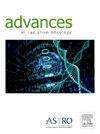A Randomized Trial on Accelerated Versus Standard Small-margin Radiation Schedule in Patients With Prostate Cancer Treated With Combined Brachytherapy and External Beam Radiation Therapy: Toxicity Outcomes and Patterns of Prostate Movement
IF 2.2
Q3 ONCOLOGY
引用次数: 0
Abstract
Purpose
Hypofractionated radiation therapy requires high accuracy in dose delivery to enable reduced treatment margins and minimize the dose to organs-at-risk. The purpose of this study was to evaluate whether accelerated (delivered 5 times per week) hypofractionated external beam radiation therapy (EBRT) can be performed without increased acute toxicity using a real-time tracking system. We also aimed to investigate patterns of intrafractional prostate movements.
Methods and Materials
Patients with prostate cancer planned for combined high dose rate brachytherapy (14.5 Gy × 1) and EBRT (3 Gy × 14) were included in this randomized trial to receive the EBRT part of the treatment either 3 or 5 times per week. EBRT was delivered using small margins (3 mm) using the Raypilot system for real-time tracking of intrafractional prostate movements. Movements were continuously monitored in 3 dimensions. Primary endpoint was toxicity that was assessed using patient-reported outcome measures through european organisation for research and treatment of cancer (EORTC) quality of life questionnaires QLQ-C30 and QLQ-PR25.
Results
During June 2018 to January 2020, 34 patients (median age 70 years) were included in the study of which 17 were randomized to each group. No statistically significant differences in toxicity were found between the study groups. Target displacement was <2 mm during 97.0% of the time and <3 mm during 99.9% of the active treatment time.
Conclusions
We found no evidence of increased acute toxicity in patients who received accelerated treatment schedule. Provided that the target is properly delineated, a 3 mm margin seems to be feasible and safe when using a real-time tracking system.
前列腺癌患者联合近距离放疗和外束放疗的加速与标准小间隙放疗方案的随机试验:毒性结局和前列腺运动模式
目的:低分割放射治疗需要高精度的剂量传递,以减少治疗间隙,并将对危险器官的剂量降至最低。本研究的目的是利用实时跟踪系统评估是否可以在不增加急性毒性的情况下进行加速(每周5次)低分割外束放射治疗(EBRT)。我们还旨在研究前列腺运动的模式。方法和材料计划接受高剂量率近距离放疗(14.5 Gy × 1)和EBRT (3 Gy × 14)联合治疗的前列腺癌患者纳入本随机试验,每周接受3或5次EBRT部分治疗。EBRT采用小间隙(3mm),使用Raypilot系统实时跟踪前列腺运动。在三维空间中连续监测运动。主要终点是毒性,通过欧洲癌症研究和治疗组织(EORTC)生活质量问卷QLQ-C30和QLQ-PR25使用患者报告的结果测量进行评估。结果2018年6月至2020年1月,34例患者(中位年龄70岁)纳入研究,其中17例随机分为每组。在毒性方面,研究小组之间没有发现统计学上的显著差异。目标位移在97.0%的时间内为2mm,在99.9%的有效处理时间内为3mm。结论:我们没有发现接受加速治疗方案的患者急性毒性增加的证据。在使用实时跟踪系统时,只要目标被正确划定,3毫米的距离似乎是可行和安全的。
本文章由计算机程序翻译,如有差异,请以英文原文为准。
求助全文
约1分钟内获得全文
求助全文
来源期刊

Advances in Radiation Oncology
Medicine-Radiology, Nuclear Medicine and Imaging
CiteScore
4.60
自引率
4.30%
发文量
208
审稿时长
98 days
期刊介绍:
The purpose of Advances is to provide information for clinicians who use radiation therapy by publishing: Clinical trial reports and reanalyses. Basic science original reports. Manuscripts examining health services research, comparative and cost effectiveness research, and systematic reviews. Case reports documenting unusual problems and solutions. High quality multi and single institutional series, as well as other novel retrospective hypothesis generating series. Timely critical reviews on important topics in radiation oncology, such as side effects. Articles reporting the natural history of disease and patterns of failure, particularly as they relate to treatment volume delineation. Articles on safety and quality in radiation therapy. Essays on clinical experience. Articles on practice transformation in radiation oncology, in particular: Aspects of health policy that may impact the future practice of radiation oncology. How information technology, such as data analytics and systems innovations, will change radiation oncology practice. Articles on imaging as they relate to radiation therapy treatment.
 求助内容:
求助内容: 应助结果提醒方式:
应助结果提醒方式:


